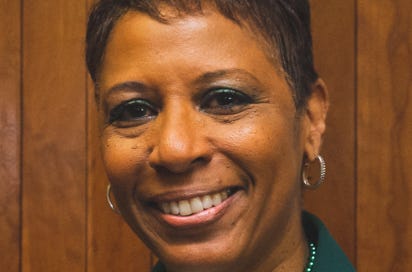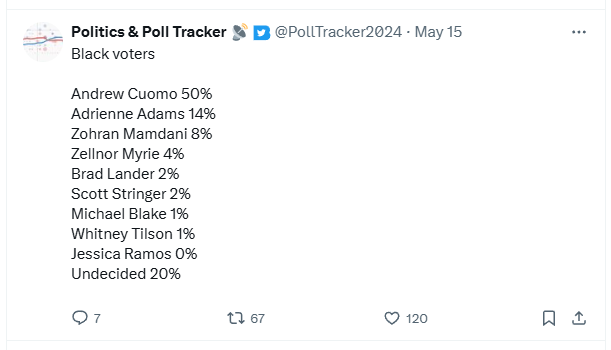You still have to be strategic in Ranked Choice Voting
Everyone who isn't Adrienne Adams should drop out of the race for NYC Mayor
I like Ranked Choice Voting (RCV). I think it’s a decent voting system that fixes some of the issues with First-Past-The-Post, although it’s not without its own downsides.
One thing that frustrates me though is the idea that RCV means you don’t have to be strategic with your vote. In this school of thought, you achieve the best outcome for yourself by simply ranking the candidates according to your genuine preference ordering. However this is not the case, nor is it the case that factions & interest groups don’t have to be strategic about who they throw support behind, and it has important implications for RCV elections such as the Democratic Primary for NYC Mayor happening in a month’s time. Here are four reasons why strategy is important in an RCV election, and what this means for progressives trying to beat Andrew Cuomo in New York.
1) Limits on how many candidates you can rank
This one might seem obvious but it bears mentioning. In NYC you can only rank up to five candidates, and there are many more than five candidates. This means that, if the two candidates who are likeliest to make it to the final round of RCV are 6th and 8th in your preference ordering, you should rank that 6th candidate in your top five, otherwise your vote will be exhausted by the final round. For a progressive voter in NYC this means ranking Zohran Mamdani in your top five, regardless of where he is in your preference ordering, provided he’s above Andrew Cuomo.
2) Some voters will always exhaust their ballots
Voters cannot be relied on to heed the advice in 1), and sometimes a race is so messy it can be hard to know who’s likely to make it to the top two. As a result, you will always see a meaningful portion of voters exhaust their ballots before the final round. This happens even in other RCV elections where, unlike NYC, you are allowed to rank as many candidates as you wish. It’s just unavoidable (unless you’re in Australia and required to rank every candidate).
In the NYC primary four years ago, a full 14% of ballots were exhausted in the final round of Eric Adams vs Kathryn Garcia. Over a quarter of people who didn’t pick Adams or Garcia as their #1 also failed to rank either in their top five. This isn’t just an unfortunate feature of the election system; it actually changed the outcome of the election. Adams defeated Garcia by 0.8%, but if you assume that exhausted ballots had broken the same way as non-exhausted ballots, given each voter’s first choice (e.g., Wiley voters prefer Garcia to Adams at the same rate, regardless of whether they exhausted their ballots or not), Garcia would’ve triumphed by 3.4%. She would also have won under a looser set of assumptions.
What does this mean, this time around? It means that progressives are shooting themselves in the foot by running so many candidates. Yes, ranked choice means that fewer votes will be wasted, but every time a candidate is eliminated, some of their votes are gone for good. It’s like moving water from one bucket to another, but every time you do, you pour a little down the drain. It’s a great way to run out of water. If progressives are serious about wanting to beat Cuomo, they need to consolidate around one candidate and have the other candidates drop out.
One potential counter-argument is turnout; voters are likelier to turn up to the polls if they have more options. I think this effect is real, but is small compared to the exhausted ballot effect. If, in 2021, third-place finisher Maya Wiley had dropped out before the election and endorsed Kathryn Garcia, there would’ve been some Wiley supporters who didn’t vote, but I expect this number would’ve been much smaller than the number of Wiley voters who, in actuality, declined to rank Garcia in their top five.
3) Candidates have to make it to the final round
In RCV, there is a strong correlation between how many first-preference votes a candidate receives, and how they fare in the final round, but it’s not perfect by any means. Many candidates, particularly extreme ones, have a strong base of support but struggle to get to 50%. We saw an example of this in New York in 2021. There, the penultimate round was Eric Adams with 40.5%, Kathryn Garcia with 30.5%, and Maya Wiley with 29.1%. If Adams had done marginally worse and Wiley marginally better, i.e., Adams 39.5%, Garcia 30.5%, Wiley 31%, there would’ve been an Adams vs Wiley final round, which Adams would’ve won easily. Meanwhile Garcia would’ve been narrowly eliminated, despite the fact that she would’ve beaten Adams head-to-head.
There’s nothing strictly wrong with the above scenario from a neutral position of trying to design good voting systems, but if you’re a progressive whose preference ordering goes Wiley > Garcia > > Adams, you would’ve really screwed yourself over by putting Wiley ahead of Garcia, even though that was your genuine preference. It would’ve been wiser to be aware that Wiley was going to have a tough time beating Adams in the final round, given her position on the ideological left, and settle for Garcia as a more electable candidate. This example should make it clear that RCV does not exempt you from considerations of electability. Ranking your preferred, but unelectable candidate #1, and then a less-preferred but more electable candidate #2, does nothing to help you if the latter candidate gets eliminated first.
For this year’s election in New York, this means ranking both Mamdani (the likeliest progressive to make it to the final round), and another progressive, who might have an easier time beating Cuomo. It’s a difficult balancing act between candidates who would do well in the final round vs candidates who have any chance of making it to the final round, but I think these trade-offs are best managed by Adrienne Adams, the speaker of the NYC City Council who recently got 9% in a poll and has the best hope of matching Cuomo with Black voters. My recommendation is to rank her ahead of Mamdani, since on the current trajectory, she will get eliminated first and Mamdani will go on to lose to Cuomo in a landslide.
4) Candidates compete for attention, money, endorsements
After this election is over, I expect my hope for consolidation around an electable progressive will have failed. The final RCV round will feature a crushing Cuomo victory over Zohran Mamdani, and progressives will despair. I also expect that, when we receive the Cast Vote Record data, allowing us to simulate RCV matchups between other pairs of candidates, this data will show that Adrienne Adams losing to Cuomo by even more than Mamdani did. Yet, I still believe she’s the candidate who’s got the best shot of defeating Cuomo. Why is that?
The reason is that there is a lot more flexibility in who the progressive coalition will get behind, compared with who Cuomo-curious voters are willing to tolerate. If every progressive other than Adrienne Adams dropped out of the race tomorrow, I have a good deal of confidence that progressive voters across NYC would get behind her, and she would defeat Cuomo in a landslide in ultra-left neighborhoods. It might not happen, we don’t know for sure, but I feel good about the chances. However if every progressive but Zohran Mamdani dropped out, I have almost no hope he’d defeat Cuomo head-to-head. The voters who decide that election are just too opposed to some of his left-wing ideas for that race to go any other way. If he were Black and had more pull with Black voters, things might be different, but as it is his path to victory would be extremely narrow.
Adrienne Adams is struggling to get first round preferences right now not so much because her ideology is toxic to many New Yorkers, as Mamdani’s is, but because she is competing for a limited slice of the progressive ecosystem. She needs money, she needs media coverage, she needs endorsements, but there’s only so much to go around and there’s too many candidates to share it with. I believe there are many voters who will rank Mamdani first, and not rank Adrienne Adams at all, who would be reliable Adams voters in a hypothetical two-way election between her and Cuomo. They won’t rank her next month simply because they don’t know much about her, and that is the biggest thing holding her back right now. The same can be said of many of the lower-tier candidates, but I’ve chosen to focus on Adams because of her potential for a strong final round performance.
In other words, don’t take Mamdani’s current polling lead over Adams as a strong indicator that he’s a better pick to go up against Cuomo. She has a much better upside, if she can just get off the ground.
Conclusion, and an endorsement
Crucially, the presence of ranked choice voting in an election does not remove the need for strategy, whether as an individual voter deciding who to rank, or as a faction deciding who to throw support behind. Even under RCV, is still extremely possible to throw away winnable elections due to poor strategy.
Because of this, I am recommending any readers of this Substack who live in New York City and care about stopping sex pest Andrew Cuomo from becoming Mayor, to rank Adrienne Adams first in the Democratic Primary. Strategy still counts for something.





![r/dataisbeautiful - [OC] Sankey Diagram Of NYC June 2021 Dem Mayoral Primary Ranked Choice Election generated with D3 via Angular using round-by-round aggregations published by NYC Board of Elections r/dataisbeautiful - [OC] Sankey Diagram Of NYC June 2021 Dem Mayoral Primary Ranked Choice Election generated with D3 via Angular using round-by-round aggregations published by NYC Board of Elections](https://substackcdn.com/image/fetch/$s_!lNEJ!,w_1456,c_limit,f_auto,q_auto:good,fl_progressive:steep/https%3A%2F%2Fsubstack-post-media.s3.amazonaws.com%2Fpublic%2Fimages%2F336af400-c612-4da7-9703-4a5a7624c585_1646x822.png)



Great post, I would add my theory that there's a funny quirk to RCV local elections in the US where us progressives/liberals get so focused on the idea of strategic voting, we forget about strategic politics. The 2021 Minneapolis mayoral election is a good example. As a longtime student and sometime participant in Minneapolis politics I really thought that after everything that happened in the summer of 2020 (perhaps you've read about it...) Mayor Jacob Frey wouldn't run again (indeed maybe resign because at times he seems to have taken criticisms of him quite personally). But then he did run again and a guy I assume could never win reelection did (how do you preside over, well, everything that happened and win? I guess you just do?) Frey's opponents bet big on a "Don't Rank Frey" strategy that makes sense on a voter level (and only 3 rankings allowed in Minneapolis) but tons of voters just didn't follow, see here for more: https://www.mprnews.org/story/2021/11/04/how-jacob-frey-won-reelection
Personally I would have suggested finding a bigger candidate to take him on, but in the end it was a community activists who had never been involved in politics until 2020 and a former state legislator from the suburbs with few ties to the city. So a ton of people just well, "Did The Cuomo" and voted for Frey, or alternatives often in a non-strategic manner.